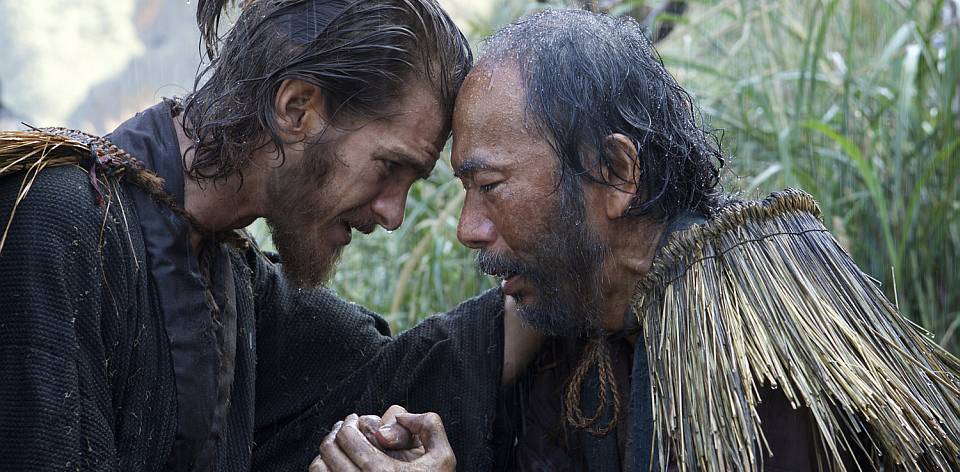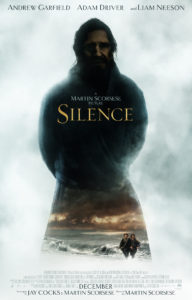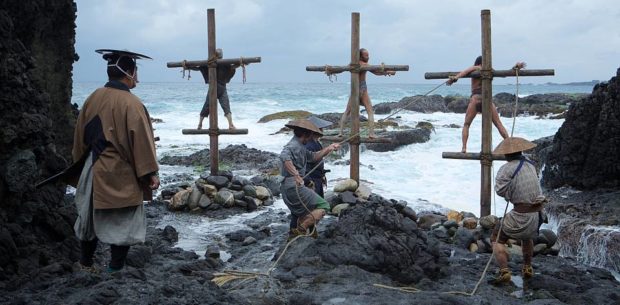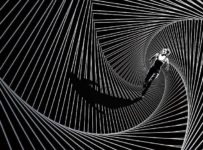The weight of Catholicism, or at least the notion of faith more broadly, has always driven the films of Martin Scorsese. Ejected from a seminary as a young man, his struggles with faith are seen as early as the Catholic guilt of Who’s That Knocking at My Door (1967), the Christ-like martyr of Jake LaMotta in Raging Bull (1980) and the genuine article in The Last Temptation of Christ (1988). SILENCE is a continuation of this highly personal dialogue, filtered through the weight of doubt that burdens almost everyone on screen.
In an incredibly faithful adaptation of the novel by Japanese author Shūsaku Endō, writers Jay Cocks and Scorsese’s script begins with word that Father Cristóvão Ferreira (Liam Neeson), a Portuguese priest in Japan, has apostatized. The unwavering faith of Fathers Rodrigues (Andrew Garfield) and Garupe (Adam Driver) leads them to Japan, where Christianity has been banned under penalty of torture and execution. Their journey leads Rodrigues in particular to question his purpose, as the perceived silence of his god begins challenging his faith and questioning his moral centre.
When you step out of the main train station in modern Nagasaki, there is a monument to the 26 martyred saints of Japan. The silent modern art piece is underpinned by a legacy of Christian persecution in the country, although these days is somewhat subdued by the memorial to the city’s atomic destruction that occurred within living memory. Scorsese’s remarkable achievement in SILENCE is not only capturing the spirit of Endō’s work, but in bottling that whole history into a single (albeit lengthy) film.
Interestingly enough, it is the length of the piece that conveys much of Endō’s meaning with an appropriately silent level of visual storytelling, something the more compressed 1971 Masahiro Shinoda film failed to achieve. (Indeed, Endō was never satisfied with this earlier adaptation of his work). Written as an epistolary novel, the film’s reverential power comes in Grafield’s narrative voice over, and even through some unnecessary laboured accents both Garfield and Driver exemplify this inner turmoil. Yosuke Kubozuka is ideal as Kicihijiro, the Judas representative for Rodrigues’ perceived Christlike trials. Kichijiro is a source of unlikely humour as well, and his constant pleas for confession constrast with Rodrigues’ inner struggle. The crucial climax of the film, one that gets to the heart of the exploration of faith versus doubt, works because of the long takes that are filled with a mixture of contemplation and breathtaking Rodrigo Prieto photography.
There are few films still being made in the vein of SILENCE, a truly spiritual exploration that doesn’t require the audience to share the doctrine. Unlike more literal Christ stories, such as Mel Gibson’s The Passion of the Christ, Scorsese and Endō’s narrative doesn’t so much burden the viewer with Catholic guilt as deliver a testament to its endurance. Scorsese’s passion project may have been in development for almost thirty years, but it is unquestionably his most powerful crafted piece in the last two decades.
[stextbox id=”grey” bgcolor=”F2F2F2″ mleft=”5″ mright=”5″ image=”null”]2016 | US | DIR: Martin Scorsese | WRITER: Jay Cocks, Martin Scorsese (Based on the novel by Shūsaku Endō) | CAST: Andrew Garfield, Adam Driver, Tadanobu Asano, Ciarán Hinds, Liam Neeson | DISTRIBUTOR: Transmission Films | RUNNING TIME: 161 minutes | RELEASE DATE: 16 February 2017 (AUS) [/stextbox]






